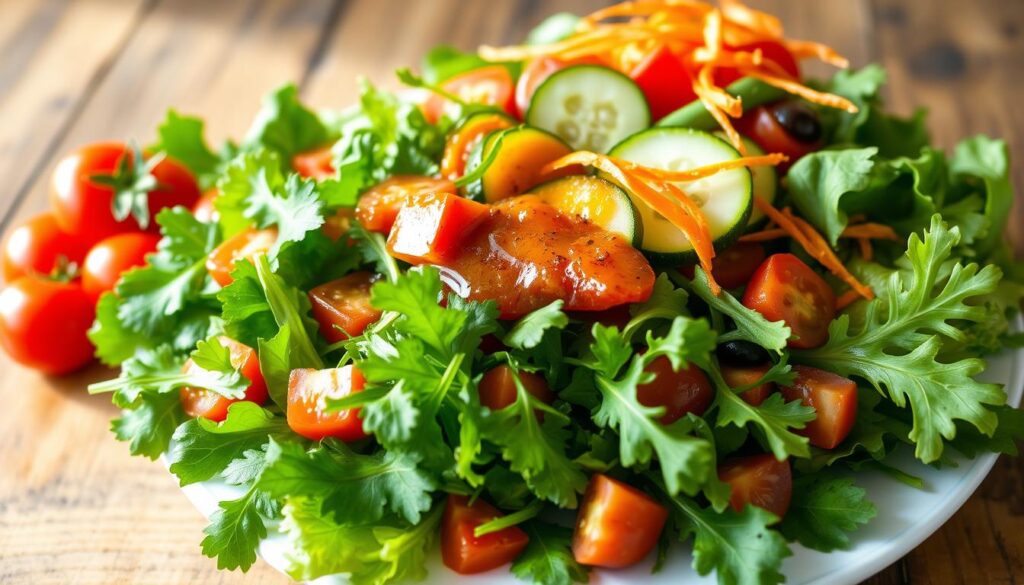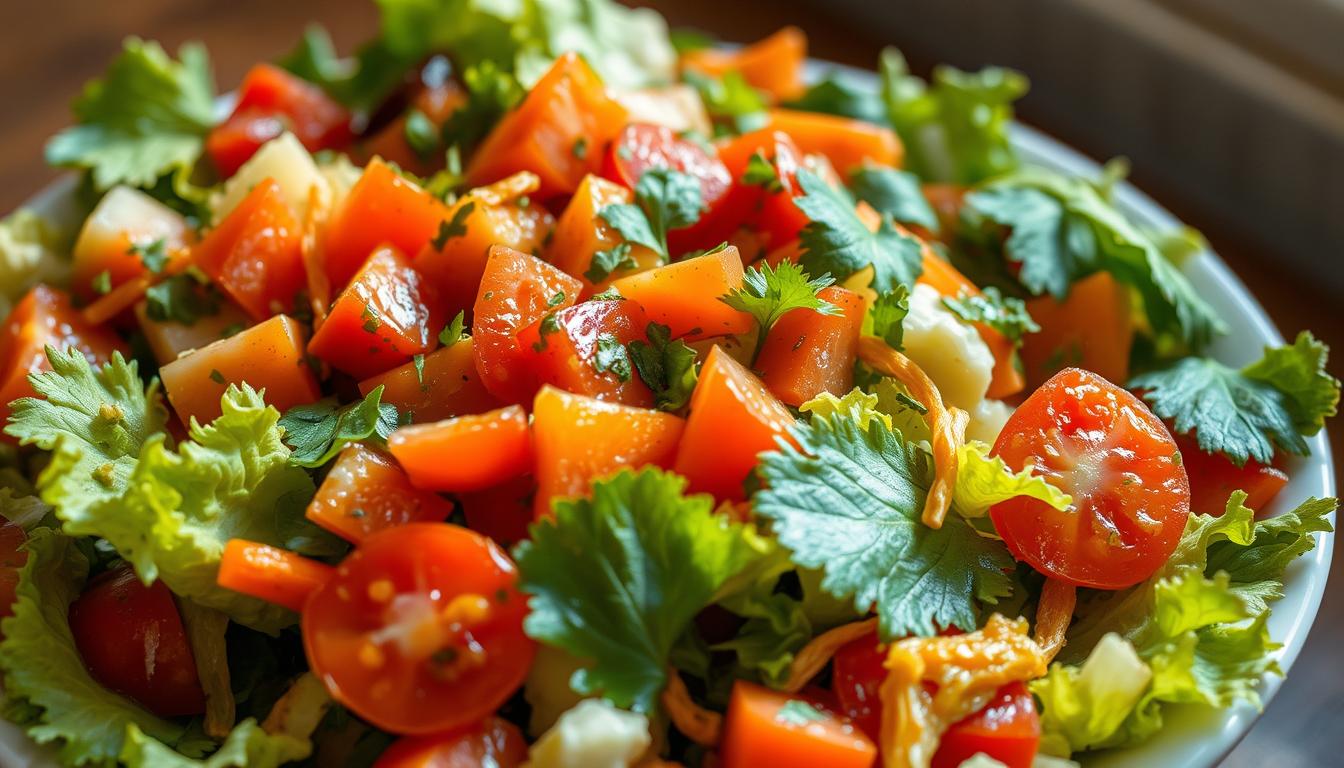Spending time chopping veggies for a garden salad can be frustrating if it tastes bland. Homemade salads often lack the bold flavors found in restaurant dishes. But, with a few tweaks, your salad can become a highlight of your meals.
It’s not just about adding a store-bought dressing. It’s about making simple ingredients shine. Imagine a crisp romaine base, juicy tomatoes, and a tangy vinaigrette. That’s how you turn a basic salad into a flavorful feast.
Think of a salad with crisp romaine, sweet tomatoes, and a tangy vinaigrette. That’s the secret to a salad that feels like a celebration. This guide will show you four ways to make your salad better. From using herbs in oils to finding the perfect dressing ratio, we’ve got you covered.
Key Takeaways
- Make a garden salad with vinaigrette in just 7 minutes for 4-5 people.
- Use a 1:3 vinegar-to-olive oil ratio as your flavor foundation.
- Boost freshness with 5-6 handfuls of leafy greens like oak leaf or baby spinach.
- Four techniques to enhance texture, acidity, and depth of flavor covered step-by-step.
- Customize dressings with options like apple cider vinegar or citrus zest for restaurant-quality taste.
Why Your Homemade Salads Need a Flavor Upgrade
Ever wonder why your homemade salad feels like a missed opportunity? Only 1 in 10 Americans eat enough veggies, often because salads taste bland. A tasty tossed salad starts with knowing where we go wrong.
Common Pitfalls of Bland Garden Salads
- Over-reliance on iceberg lettuce and basic veggies like cucumbers or tomatoes
- Skipping seasoning until the end, leaving flavors disconnected
- Using store-bought dressings loaded with additives instead of fresh ingredients
The Secret Sauce: Mastering Vinaigrettes
A good vinaigrette is more than just liquid—it’s what holds your fresh greens together. Kitchens use a 3:1 oil-to-acid ratio, but the real secret is emulsifiers like Dijon mustard. This makes the dressing stick to every leaf, not just pool at the bottom.
What Restaurants Do Differently
Restaurants succeed by:
- Using peak-season produce for maximum flavor (like crisp romaine instead of wilted lettuce)
- Seasoning ingredients at every stage, not just the final toss
- Adding texture layers with toasted nuts, crispy bacon, or tangy cheese
They also avoid the $9 jarred dressings you find in supermarkets, opting for house-made blends instead.
Upgrading your homemade salad doesn’t need fancy tools—just smart tweaks. Start with quality oils and try herb-infused bases. Your taste buds (and vitamin intake) will love you for it.
Essential Ingredients for the Perfect Garden Salad with Vinaigrette
Choosing the right ingredients makes your garden salad with vinaigrette stand out. Start with leafy greens like crisp romaine or peppery arugula. Add crunchy elements like radishes or roasted red peppers for texture.
Boost the flavor with maple syrup or balsamic vinegar. Finish with proteins like beans or almonds for a filling meal.

| Category | Ingredients | Why It Works |
|---|---|---|
| Leafy greens | Romaine, kale, spinach | Provide structure and freshness |
| Crunchy elements | Radishes, green onions, almonds | Texture contrast |
| Flavor boosters | Roasted red peppers, kalamata olives | Umami depth |
| Proteins | White beans, grilled chicken | Satiety and richness |
For the vinaigrette, mix 4 tbsp extra virgin olive oil with 1 tbsp balsamic vinegar. Add fresh oregano, maple syrup, salt, and pepper. This ratio gives a balanced tanginess without overpowering the greens.
Try adding citrus zest or mustard for extra brightness.
| Nutrition Facts (per serving) | Amount | % Daily Value |
|---|---|---|
| Calories | 426 | – |
| Protein | 14g | 8% |
| Fiber | 12g | 48% |
| Potassium | 1086mg | 31% |
| Vitamin A | 12,277 IU | 245% |
Pair this salad with seasonal veggies like cherry tomatoes or cucumber. They add vibrant color and texture. Adjust the ingredients to your liking, but always use fresh ones for the best flavor.
The Science Behind Vinaigrettes: Emulsions Explained
Ever wondered why store-bought salad dressing stays mixed, while homemade versions often separate? The secret lies in emulsions—temporary bonds that keep oil and vinegar blended. Mastering this science turns basic oil and vinegar into a creamy balsamic vinaigrette that sticks to greens.
Oil and Vinegar: Finding the Perfect Ratio
Start with a 3:1 oil-to-vinegar base. This ratio works for most salad dressing, but adjust to taste. A tangyier 2:1 ratio suits sharp balsamic vinaigrette. Mix equal parts olive oil and vinegar to test your preference. Pro tip: Measure by drops, not volume, to avoid over-oiling leafy greens.
Emulsifiers: The Secret to Smooth Dressings
Emulsifiers like Dijon mustard act like molecular glue. Their tiny particles cling to both oil and vinegar, preventing separation. Try these pantry staples:
- 1 tsp Dijon mustard thickens vinaigrettes instantly
- Honey or garlic paste adds clingy syrup-like bonds
- Egg yolk (in mayo-style dressings) creates lasting stability
Mustard’s pectin molecules form a net that traps oil droplets in vinegar.
How Temperature Affects Your Vinaigrette
Cold oil and vinegar won’t blend well—warm ingredients to room temperature first. Refrigerated dressings thicken, so bring to room temp before tossing. Properly emulsified dressings stay stable up to a week, while unemulsified mixtures separate in 5 minutes. Shake before use if stored cold.
Flavor Booster #1: Infusing Oils with Herbs and Aromatics
Boost your salad dressing with flavor without extra calories. Infuse oils with fresh herbs and aromatics. This trick turns simple greens into a healthy eating favorite, just like restaurant dishes. Choose high-quality oils like extra virgin olive oil (EVOO) for their rich taste.
Herb-Infused Olive Oil Techniques
Warm oils with herbs like basil or cilantro gently on low heat (below 350°F). This avoids burning. For a deeper taste, steep rosemary or thyme in oil at room temperature for 24–48 hours. Shake it daily to mix the flavors well.
Using Garlic, Shallots, and Citrus Zest
Enhance flavor by steeping finely chopped garlic or shallots in oil for 1–2 days. Add lemon or orange zest for a burst of citrus. But, don’t overheat to keep their flavors fresh.
Storage Tips for Flavored Oils
Keep infusions in clean jars in the fridge for up to 3 weeks. Always use clean tools to prevent contamination. If you notice bad smells or mold, throw it away for safety.
Flavor Booster #2: Balancing Acidity with Premium Vinegars
Premium vinegars can turn a simple garden salad with vinaigrette into a rich dish. Look beyond white vinegar. Aged balsamic vinaigrette bases, for example, bring a sweet caramel taste. This pairs well with peppery arugula or bitter greens.
| Vinegar Type | Flavor Profile | Best For |
|---|---|---|
| Balsamic (aged) | Sweet, tangy, oaky | Caprese salads, figs, or roasted veg |
| Sherry vinegar | Dried fruit notes, nutty | Spanish-inspired salads |
| Black vinegar | Smoky, licorice-like | Asian salads with sesame or soy |
| Red wine vinegar | Dry, fruity | Classic garden salads |
Begin with a 3:1 oil-to-vinegar ratio in dressings, then adjust to taste. For sharp vinegars like sherry or rice wine, start with a smaller amount. Mixing balsamic vinaigrette with citrus juice adds a bright touch. Black vinegar, priced $2.89–$3.79, mixed with ginger and scallions makes a great garden salad with vinaigrette base. Always taste as you go—the right vinegar can make leafy greens shine just like the best olive oil.
Flavor Booster #3: Incorporating Sweet Elements to Your Vinaigrette
Adding a touch of sweetness can make your salad dressing stand out. The goal is to find the right balance. Sweetness should add depth without overpowering your nutritious meal.

Natural Sweeteners That Complement Salad Greens
Opt for sweeteners that add a hint of complexity:
- Honey: Adds floral notes. Start with 1 tsp per ½ cup dressing.
- Maple Syrup: Rich caramel flavor. Use ½ tsp in citrus-based vinaigrettes.
- Agave Nectar: Light texture pairs well with peppery arugula.
Fruit-Based Additions for Complexity
Blend or muddle fruits to infuse vinaigrettes without diluting them:
| Fruit | Best Use |
|---|---|
| Strawberry Puree | Whisk into balsamic vinaigrettes for summer salads |
| Pomegranate Molasses | Enhances earthy greens like kale |
| Roasted Figs | Blend into walnut oil-based dressings |
Creating a Sweet-Tart Balance
Pair sweetness with acidity to avoid cloying flavors. For every 1 tbsp sweetener, add 1 tsp vinegar. Test this ratio in:
- Apple cider vinegar + honey for spinach salads
- Lemon juice + pomegranate syrup for beet salads
Remember: A dash of salt amplifies sweetness while cutting bitterness in greens. Keep tasting as you adjust!
Flavor Booster #4: Adding Texture with Nuts, Seeds and Crispy Elements
Make your tossed salad a feast for the senses by adding different textures. Crispy nuts, toasted seeds, and crunchy bits turn simple greens into a healthy eating masterpiece. Each bite is a blend of soft, crunchy, and chewy, making meals more filling and enjoyable.
Toasting Techniques for Maximum Flavor
Heat boosts flavors in nuts and seeds. Here are some tips:
- Spread almonds, pecans, or walnuts on a baking sheet. Toast at 350°F for 8–10 minutes until golden.
- Add smoked paprika or sea salt during toasting for extra depth.
- Let toasted ingredients cool completely before adding to salads to retain crunch.
Seed Mixtures That Enhance Any Garden Salad
Make your own blends for freshness and nutrition:
- Sunflower + pumpkin seeds + sesame seeds (1:1:1 ratio) for a nutty base.
- Try chili-lime pepitas or cinnamon-spiced sunflower seeds for bold twists.
- Store mixtures in airtight containers for quick tossing into salads.
Creating Contrasting Textures in Your Bowl
Mix elements like:
- Crunchy: Homemade croutons, crispy chickpeas, or roasted beets.
- Crispy: Kale chips or thinly sliced jicama.
- Soft: Avocado slices or ripe mango.
Balance textures so every forkful has a mix. A tossed salad with varied textures is more satisfying. It helps with healthy eating by reducing unnecessary snacking.
Seasonal Adaptations: Customizing Your Garden Salad Throughout the Year
Make the most of your garden salad by changing up the ingredients with the seasons. Fresh greens and colorful vegetable mixes are best when they’re in season. Here’s how to keep your salad exciting all year:
- Spring: Start with soft fresh greens like butter lettuce or mâche. Add pea shoots, radishes, and edible flowers. Use lemon zest or dill oil in your dressing. Try pea shoots with a dill vinaigrette for a fresh mix.
- Summer: Use ripe tomatoes, cucumbers, and corn. Add sweet touches like halved cherries or grilled halloumi. A raspberry vinaigrette adds a tangy sweetness. No-cook couscous is great for quick summer meals.
- Fall: Switch to sturdy kale or radicchio for your greens. Roast butternut squash, apples, and Brussels sprouts. A pumpkin maple vinaigrette, with its roasted pumpkin and spices, enriches the mix.
- Winter: Brighten up with citrusy greens like endives. Pair with roasted root veggies and dried cranberries. A citrus-ginger vinaigrette brings out the flavors of beets and blood oranges.
Adjust the mix to get the right texture and taste. Keep vinaigrettes in the fridge for up to 5 days. Let local markets guide you—seasonal produce tastes better and saves money.
Nutritional Benefits of Fresh Leafy Greens and Homemade Vinaigrettes
Choosing leafy greens and homemade dressings isn’t just about taste—it’s a step toward healthier eating. Let’s explore how these choices boost your meals’ nutritional value.
Why Homemade Dressings Outshine Store-Bought Options
Homemade vinaigrettes avoid additives like artificial preservatives and excess sugar. Compare store-bought dressings, which often add 200+ calories per cup, to your own creations:
- Balsamic vinaigrette: 166 calories/serving vs. 150 in homemade
- Greek yogurt ranch: 29 calories/serving, 2g protein
Control ingredients to align with your nutritious meal goals.
Nutrient Profiles of Different Salad Greens
| Green Type | Vitamin A (IU) | Vitamin C (mg) | Iron (mg) |
|---|---|---|---|
| Spinach | 5,613 | 29 | 0.8 |
| Kale | 8,929 | 134 | 0.6 |
| Romaine | 1,629 | 13 | 0.5 |
Healthy Fats and Their Role in Nutrient Absorption
Healthy fats like olive oil in vinaigrettes boost absorption of vitamins A, D, E, and K. For example, pairing spinach (rich in fat-soluble vitamins) with 2 tbsp olive oil increases nutrient uptake by 50%.
With 1 in 10 Americans falling short on daily veggies, building salads around leafy greens offers a simple solution. Prioritize healthy eating by mixing greens like arugula and romaine for varied nutrients. Your body—and taste buds—will thank you.
Make-Ahead Tips: Prep Components for Quick Weekday Salads
Want a homemade salad but don’t have time? Smart prep makes fresh greens easy for weeknights. Begin by washing and drying greens well. This prevents moisture from causing them to spoil.
Pat them dry with a towel. Store them in a sealed container with paper towels to soak up moisture. Hardier greens like kale or cabbage are best dressed ahead of time.
- Greens: Keep unwashed greens in breathable bags for up to 5 days. Spinach and lettuce stay fresh longer if kept dry.
- Proteins: Roast chicken or chickpeas ahead of time. Cook 1 cup quinoa with 1¾ cups water for 12-15 minutes.
- Vegetables: Chop bell peppers, cucumbers, and cherry tomatoes. Store avocado halves in sealed bags with lemon juice to prevent browning.
- Vinaigrettes: Make large batches using 2 Tbsp olive oil and lime juice. Store in airtight jars. Re-emulsify separated dressings by shaking well.
Assemble salads at mealtime by layering prepped items in jars. Start with grains, add proteins, top with greens, and add dressing last. A classic combo includes roasted sweet potatoes, mango, and corn with a balsamic vinaigrette.
Meal prepping saves a lot of time—up to hours weekly. 60% of prep involves ingredient prep, 30% batch cooking, and 10% ready-to go.
For longer shelf life, store nuts and seeds separately. Add hemp seeds or sunflower seeds just before serving. Prepped salads with vegetarian proteins like chickpeas last up to a week.
Remember: keep dressings and wet ingredients separate until serving to retain crunch.
From Basic to Gourmet: Elevate Your Salad Game Today
Take your garden salad with vinaigrette from basic to gourmet. Use infused oils, balanced acidity, sweet touches, and textures. This mix makes a nutritious meal that’s as good as what you find in restaurants.
Begin with a simple Greek salad. Mix 2 parts olive oil with 1 part vinegar. Add minced shallots and toasted almonds. This quick recipe serves 4 and gets a 4.98/5 rating.
For weekend fun, add all four boosters to your salad. Use herb-infused oil, a honey and vinegar mix, and crisp veggies. For a dinner party, layer Danish blue cheese, roasted seeds, and citrus zest vinaigrette. Serve on a wide plate to show off colors and textures.
These tips turn garden salad with vinaigrette into a base for healthy, creative meals. Mastering ratios and flavors makes even simple greens taste great. Whether for lunch or a dinner party, these ideas make salads a hit. Start small, get confident, and see how simple steps make every bite better.
Healthy cooking doesn’t have to be hard. A few smart additions can make your salads exciting and healthy. Let these recipes motivate you to try new things. Every change brings you closer to making the perfect nutritious meal.

